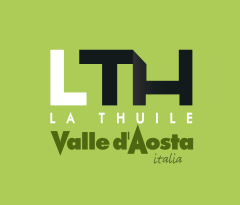Bike from La Thuile
Bike from La Thuile
Hard
Difficulty16,7km
Distance+679m
Positive Elevation-921m
Negative ElevationEmbed this item to access it offline
Between La Thuile and La Rosière, along mountains that welcome skiers in winter, there is a cross-border itinerary dedicated to trained and experienced cyclists, which runs along beautiful tracks and paths, crosses forests and alpine meadows and offers precious panoramic points.
An energised ride through nature that also stimulates the mind: many stages to indulge in to fill your eyes with culture and beauty.
An energised ride through nature that also stimulates the mind: many stages to indulge in to fill your eyes with culture and beauty.
Description
Leaving the car at the La Thuile cable car park, use the Bosco express and Chalet express chairlifts in sequence, which are equipped to transport bicycles in the summer, serving the bike area. Once you reach the top at an altitude of about 2350 m, take the road downhill until you reach the track that climbs from Les Suches. Proceed uphill for about 3 kilometres and 260 m of altitude difference, to the Monte Belvedere pass (about 2580 m). Turn left to reach the arrival station of the Bellecombe 2 lift. Keeping to the side of the lifts and following the tracks of the farm roads, descend to an altitude of 2200 m. Shortly before the departure station of the Bellecombe 1 ski lift, turn right, leaving the farm road that you have been following until now. You find yourself pedalling along a path through meadows leading towards the Petit St Bernard pass. When you reach the hospice, cross the tarmac road, keep the wetland on your right and take the path behind the building. At the fork in the path, keep to the left, skirting the downhill stream. When you reach the asphalt road again, follow it downhill for about 1 km, then take the dirt road on the right that leads to Les Gouillons lake. From here, follow the downhill path for about 1.5 km and 150 m D- that runs alongside the Torrent du Reclus. At the farm road, turn left and uphill again to reach the asphalt road, which you must follow for about 1.25 km. Take the dirt track on the left that runs alongside the asphalt road until the start of the Clarines plant. Take the tarmac road again as far as the village of La Rosière, then go uphill, following the signs towards Les Chavonnes Hautes and the area where the La Rosière golf course is located.
Departure : La Thuile
Arrival : La Rosière
3 points of interest

Geology
Terres Noires
The name Terres Noires immediately refers to the dark colour of the rocky outcrops found in this area, linked to the presence of coal.
Geologically speaking, we are in a broad anthracite belt that starts in the Maurienne in Savoie and extends into the Aosta Valley via the Petit St Bernard and on into Switzerland. Anthracite is a fossil coal with a high carbon content derived from the transformation of ancient plant deposits that became trapped during sedimentation on the seabed. In 1749, on the orders of King Charles Emmanuel III, the inspector of mines Nicolas de Robilant also made inspections in this area, describing vast coal outcrops used as fuel for metalworking, lime kilns and domestic heating.
Terres Noires is also remembered for a bloody episode that occurred at the end of World War II, in August 1944.
German troops retreating from the Rhone valleys after the Allied landings and the progressive liberation of the occupied territories raided along the way and took a group of 28 Savoyard civilian hostages to protect themselves from the partisan guerrillas.
Shortly after the Little St. Bernard Pass, the prisoners were shot and buried in two mass graves. Their bodies were only found in the summer of 1945 when the snow melted. On 28 July 1945, a solemn funeral was held in Moûtiers in the presence of a large crowd. A monument commemorates this episode.
Geologically speaking, we are in a broad anthracite belt that starts in the Maurienne in Savoie and extends into the Aosta Valley via the Petit St Bernard and on into Switzerland. Anthracite is a fossil coal with a high carbon content derived from the transformation of ancient plant deposits that became trapped during sedimentation on the seabed. In 1749, on the orders of King Charles Emmanuel III, the inspector of mines Nicolas de Robilant also made inspections in this area, describing vast coal outcrops used as fuel for metalworking, lime kilns and domestic heating.
Terres Noires is also remembered for a bloody episode that occurred at the end of World War II, in August 1944.
German troops retreating from the Rhone valleys after the Allied landings and the progressive liberation of the occupied territories raided along the way and took a group of 28 Savoyard civilian hostages to protect themselves from the partisan guerrillas.
Shortly after the Little St. Bernard Pass, the prisoners were shot and buried in two mass graves. Their bodies were only found in the summer of 1945 when the snow melted. On 28 July 1945, a solemn funeral was held in Moûtiers in the presence of a large crowd. A monument commemorates this episode.

Small patrimony
Little Saint Bernard hospice
The Petit-Saint-Bernard hospice remains today a symbol of hospitality for all those who travel this route through the mountains. Its history is linked to the figure of Saint Bernard, archdeacon of Aosta, who around 1050 had a hospice and church built and served by religious monks dependent on the monastery of Saint Peter in the Swiss Valais.
The hospice was entrusted in 1113 to the order of the monks of Saint-Gilles of Verrès. A new hospice was built at the behest of Saint Peter II, archbishop of the Tarentaise Valley, a little further south, in its present location.
The building experienced alternating periods of decay and prosperity. From 1752, its name was linked to the Order of Saint Maurice and Saint Lazarus, and the crusader emblem of the Mauritian Order appeared on the façade.
In 1860, Abbot Chanoux arrived and contributed to guaranteeing hospitality for 50 years, both in summer and winter. In 1920, the hospice recorded a record number of passages, over 21,000 of which more than 500 in winter!
During the Second World War, the building was devastated and lay in ruins for a long time. Since the summer of 1995, thanks to cooperation between Italian and French Rotary clubs, a renovated and equipped hospice with a restaurant, rooms and tourist information point has once again become the soul of the Petit-Saint-Bernard Pass.
The hospice was entrusted in 1113 to the order of the monks of Saint-Gilles of Verrès. A new hospice was built at the behest of Saint Peter II, archbishop of the Tarentaise Valley, a little further south, in its present location.
The building experienced alternating periods of decay and prosperity. From 1752, its name was linked to the Order of Saint Maurice and Saint Lazarus, and the crusader emblem of the Mauritian Order appeared on the façade.
In 1860, Abbot Chanoux arrived and contributed to guaranteeing hospitality for 50 years, both in summer and winter. In 1920, the hospice recorded a record number of passages, over 21,000 of which more than 500 in winter!
During the Second World War, the building was devastated and lay in ruins for a long time. Since the summer of 1995, thanks to cooperation between Italian and French Rotary clubs, a renovated and equipped hospice with a restaurant, rooms and tourist information point has once again become the soul of the Petit-Saint-Bernard Pass.

Small patrimony
The four winds and statue of Saint Bernard of Menthon
Just beyond the hospice, overlooking the French side of the Petit St Bernard Pass, is a small stone construction resembling a garret with four niches, one on each side. It was built by Abbé Chanoux, who was rector of the hospice for 49 years from 1860 until his death, to meditate while sheltered from the wind, regardless of its direction. It was later used by customs officers as a lookout post for smugglers coming up from the valley.
Next to it is an imposing statue of Saint Bernard of Menton placed in 1902 by Abbot Chanoux on a tuff pedestal over 12 m high. The figure of Saint Bernard is fundamental to the history of the Col: it was he who in 1034 received the mandate to build the hospice. The saint, depicted with his index finger pointing towards Italy to indicate the way to cross the pass, embodied, then as now, the essence of hospitality. During the Second World War, the finger was lost, leaving an outstretched fist in a more vengeful-looking gesture.
Next to it is an imposing statue of Saint Bernard of Menton placed in 1902 by Abbot Chanoux on a tuff pedestal over 12 m high. The figure of Saint Bernard is fundamental to the history of the Col: it was he who in 1034 received the mandate to build the hospice. The saint, depicted with his index finger pointing towards Italy to indicate the way to cross the pass, embodied, then as now, the essence of hospitality. During the Second World War, the finger was lost, leaving an outstretched fist in a more vengeful-looking gesture.
Altimetric profile
Access and parking
The route runs between La Thuile in Italy and La Rosière in France
Arriving from Italy: SS 26 of Valle d'Aosta until La Thuile
Arriving from Italy: SS 26 of Valle d'Aosta until La Thuile
Parking :
La Thuile cable car park. La Rosière village centre
Report a problem or an error
If you have found an error on this page or if you have noticed any problems during your hike, please report them to us here:
 Ufficio del Turismo / Office du Tourisme La Thuile
Ufficio del Turismo / Office du Tourisme La Thuile  Office de Tourisme Séez
Office de Tourisme Séez  Office du Tourisme de la Rosière Montvalezan
Office du Tourisme de la Rosière Montvalezan Espace San Bernardo ski
Espace San Bernardo ski